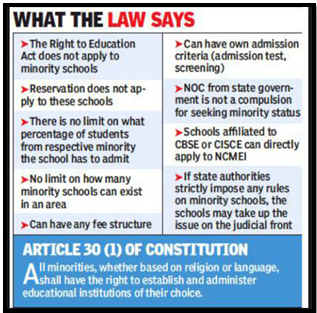SC QUESTIONS STATE RECOGNITION FOR MINORITY INSTITUTIONS
Why in the News?
- Chief Justice Chandrachud questions if establishing a minority institution depends on state recognition.
- Court queries whether specific laws automatically negate minority status, citing the 1967 AMU case.
- The inquiry stems from a reference regarding the minority status of Aligarh Muslim University (AMU) under Article 30 of the Constitution.
About Minority Educational Institutions
Source: Abhipedia
About the Dispute :
- Origin (1967): Dispute began in 1967, examining amendments to the AMU Act of 1920, altering governance structures.
- 1967 Supreme Court’s Verdict: Court ruled AMU wasn’t exclusively administered by the Muslim minority, operating under a central Act.
- 1981 Amendment:
An amendment explicitly affirmed AMU’s minority status.
- 2005 Reservation Challenge:
Allahabad High Court overturned reservations in medical courses, citing non-qualification as a minority institution.
- 2016 Appeal Withdrawal:
Government withdrew appeal, expressing concerns about establishing a minority institution in a secular state.
- Current Hearing (2019 Onwards): Three-judge Bench referred the matter to a seven-judge Bench in 2019, ongoing hearings.
What are Minority educational institutions ?
Minority educational institutions refer to schools or universities founded by religious, linguistic, or cultural minorities. These institutions often enjoy certain rights and protections under the law to preserve their distinct identity.
| About Aligarh Muslim University (AMU )
· Establishment: Established in 1875 as the Muhammadan Anglo-Oriental (MAO) College by Sir Syed Ahmad Khan · Objective: To address educational backwardness among Muslims. · Status Change :Evolved into AMU in 1920, gaining university status with assets transferred from MAO College. |

 Source: Abhipedia
Source: Abhipedia

